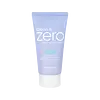What's inside
What's inside
 Key Ingredients
Key Ingredients

 Benefits
Benefits

 Concerns
Concerns

 Ingredients Side-by-side
Ingredients Side-by-side

Water
Skin ConditioningStearic Acid
CleansingPEG-8
HumectantMyristic Acid
CleansingPotassium Hydroxide
BufferingGlycerin
HumectantLauric Acid
CleansingAlcohol
AntimicrobialButylene Glycol
HumectantGlyceryl Stearate Se
EmulsifyingPolyquaternium-7
Parfum
MaskingDisodium EDTA
Sodium Benzoate
MaskingSodium Metabisulfite
AntioxidantSodium Hyaluronate
HumectantSericin
Skin ConditioningSodium Acetylated Hyaluronate
HumectantCitric Acid
BufferingPotassium Sorbate
PreservativeHydrolyzed Silk
HumectantWater, Stearic Acid, PEG-8, Myristic Acid, Potassium Hydroxide, Glycerin, Lauric Acid, Alcohol, Butylene Glycol, Glyceryl Stearate Se, Polyquaternium-7, Parfum, Disodium EDTA, Sodium Benzoate, Sodium Metabisulfite, Sodium Hyaluronate, Sericin, Sodium Acetylated Hyaluronate, Citric Acid, Potassium Sorbate, Hydrolyzed Silk
Water
Skin ConditioningSodium Cocoyl Isethionate
CleansingGlycerin
HumectantButylene Glycol
Humectant1,2-Hexanediol
Skin ConditioningPolyglyceryl-4 Caprate
EmulsifyingCoco-Betaine
CleansingOlea Europaea Fruit Oil
MaskingHydroxyethylcellulose
Emulsion StabilisingSodium Chloride
MaskingEthylhexylglycerin
Skin ConditioningBetaine
HumectantSodium Nitrate
SoothingEucalyptus Globulus Leaf Oil
PerfumingCitrus Aurantium Bergamia Fruit Oil
MaskingFerula Galbaniflua Resin Oil
AntimicrobialAnthemis Nobilis Flower Oil
MaskingRosmarinus Officinalis Leaf Oil
MaskingCentella Asiatica Extract
CleansingDisodium Phosphate
BufferingPolysorbate 60
EmulsifyingSimmondsia Chinensis Seed Oil
EmollientSodium Phosphate
BufferingAsiaticoside
AntioxidantCentella Asiatica Root Extract
Skin ConditioningCentella Asiatica Leaf Extract
Skin ConditioningCentella Asiatica Flower/Leaf/Stem Extract
Skin ConditioningBifida Ferment Lysate
Skin ConditioningArginine
MaskingLactobacillus Ferment
Skin ConditioningVaccinium Angustifolium Fruit Extract
Skin ProtectingMadecassic Acid
Skin ConditioningAsiatic Acid
Skin ConditioningMadecassoside
AntioxidantWater, Sodium Cocoyl Isethionate, Glycerin, Butylene Glycol, 1,2-Hexanediol, Polyglyceryl-4 Caprate, Coco-Betaine, Olea Europaea Fruit Oil, Hydroxyethylcellulose, Sodium Chloride, Ethylhexylglycerin, Betaine, Sodium Nitrate, Eucalyptus Globulus Leaf Oil, Citrus Aurantium Bergamia Fruit Oil, Ferula Galbaniflua Resin Oil, Anthemis Nobilis Flower Oil, Rosmarinus Officinalis Leaf Oil, Centella Asiatica Extract, Disodium Phosphate, Polysorbate 60, Simmondsia Chinensis Seed Oil, Sodium Phosphate, Asiaticoside, Centella Asiatica Root Extract, Centella Asiatica Leaf Extract, Centella Asiatica Flower/Leaf/Stem Extract, Bifida Ferment Lysate, Arginine, Lactobacillus Ferment, Vaccinium Angustifolium Fruit Extract, Madecassic Acid, Asiatic Acid, Madecassoside
 Reviews
Reviews

Ingredients Explained
These ingredients are found in both products.
Ingredients higher up in an ingredient list are typically present in a larger amount.
Butylene Glycol (or BG) is used within cosmetic products for a few different reasons:
Overall, Butylene Glycol is a safe and well-rounded ingredient that works well with other ingredients.
Though this ingredient works well with most skin types, some people with sensitive skin may experience a reaction such as allergic rashes, closed comedones, or itchiness.
Learn more about Butylene GlycolGlycerin is already naturally found in your skin. It helps moisturize and protect your skin.
A study from 2016 found glycerin to be more effective as a humectant than AHAs and hyaluronic acid.
As a humectant, it helps the skin stay hydrated by pulling moisture to your skin. The low molecular weight of glycerin allows it to pull moisture into the deeper layers of your skin.
Hydrated skin improves your skin barrier; Your skin barrier helps protect against irritants and bacteria.
Glycerin has also been found to have antimicrobial and antiviral properties. Due to these properties, glycerin is often used in wound and burn treatments.
In cosmetics, glycerin is usually derived from plants such as soybean or palm. However, it can also be sourced from animals, such as tallow or animal fat.
This ingredient is organic, colorless, odorless, and non-toxic.
Glycerin is the name for this ingredient in American English. British English uses Glycerol/Glycerine.
Learn more about GlycerinWater. It's the most common cosmetic ingredient of all. You'll usually see it at the top of ingredient lists, meaning that it makes up the largest part of the product.
So why is it so popular? Water most often acts as a solvent - this means that it helps dissolve other ingredients into the formulation.
You'll also recognize water as that liquid we all need to stay alive. If you see this, drink a glass of water. Stay hydrated!
Learn more about Water